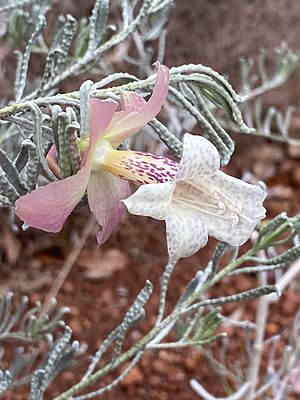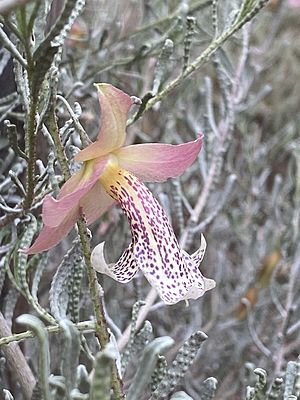Eremophila mirabilis facts for kids
Quick facts for kids Eremophila mirabilis |
|
|---|---|
 |
|
| In the Mount Annan Botanic Garden | |
| Conservation status | |
| Scientific classification | |
| Genus: |
Eremophila (plant)
|
| Species: |
mirabilis
|
Eremophila mirabilis is a beautiful flowering plant that belongs to the figwort family. It is found only in Western Australia. This plant is a shrub with narrow leaves and bright, colorful flowers. It grows in two areas that are quite far apart.
Contents
What Eremophila mirabilis Looks Like
Eremophila mirabilis is an upright shrub that can grow from about 0.3 to 1.4 meters (1 to 4.5 feet) tall. Its branches and leaves are covered with fine grey hairs. Sometimes, sticky resin makes these parts feel a bit sticky, and the hairs might be hard to see. The leaves grow one after another along the stem. They are long and narrow, about 11 to 35 millimeters (0.4 to 1.4 inches) long and 1.8 to 2.6 millimeters (0.07 to 0.1 inches) wide. They have small, raised resin glands, especially along their edges and on the bottom.
The flowers grow one by one where the leaves meet the stem, on a hairy stalk that is 6 to 12 millimeters (0.2 to 0.5 inches) long. There are five sepals, which are like small leaves that protect the flower bud. These sepals are yellow to red, about 14 to 21 millimeters (0.5 to 0.8 inches) long, and they get bigger after the flower blooms.
The petals are 25 to 35 millimeters (1 to 1.4 inches) long and are joined together at the bottom to form a tube. The petal tube and its tips are cream-colored to pale yellow. They have bright red spots on the outside, but not on the inside. The outside of the tube and both sides of the tips are smooth and without hairs. However, there is a band of soft hairs inside the tube. The four stamens, which produce pollen, stick out a little bit from the end of the petal tube. This plant flowers from July to September. After flowering, it produces oval or cone-shaped fruits with a pointed end, about 4 to 5 millimeters (0.16 to 0.2 inches) long.
How Eremophila mirabilis Got Its Name
This plant was first officially described by a scientist named Robert Chinnock in 2007. The description was published in a book called Eremophila and Allied Genera: A Monograph of the Plant Family Myoporaceae. The second part of its scientific name, mirabilis, comes from a Latin word. It means "wonderful" or "strange," probably because of its unique flowers.
Where Eremophila mirabilis Lives
Eremophila mirabilis grows in two separate places in Western Australia. One area is near Niagara, and the other is north of Mullewa. These areas are part of the Murchison and Yalgoo regions. In both places, the plants grow in stony clay soil on slopes made of laterite (a type of reddish soil).
Conservation Status
The Western Australian Government Department of Parks and Wildlife has classified Eremophila mirabilis as "Priority Two". This means that not much is known about this species, and it has only been found in one or a few locations. This classification helps protect plants that are not yet endangered but need to be watched carefully.
Using Eremophila mirabilis in Gardens
This Eremophila plant has very unusual flowers with spots on the outside of the petal tube. Its large, red or yellow sepals last a long time, making it a great choice for a garden or even a pot on a patio.
You can grow new plants from cuttings, but they often take a long time to start growing roots. A better way to grow them is by grafting. This means attaching a piece of Eremophila mirabilis onto the root system of another plant, like a Myoporum. This shrub likes soil that drains well and needs full sun. It can handle some dry weather, but it will need water during long droughts. It does not like frost, so it should be planted in a sunny, protected spot in the garden.



